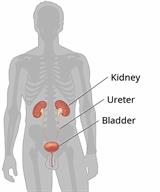Percutaneous Nephrostomy

Percutaneous nephrostomy is a procedure to insert a flexible tube into the kidney. This is done to help urine leave the body when it cannot leave the kidney in the normal way. Urine is supposed to be carried from the kidneys to the bladder through narrow tubes called ureters. But a ureter can become blocked. This may be because of kidney stones, an infection, a blood clot, or an abnormal growth of cells (tumor).
After the procedure, the nephrostomy tube will stay in place. Urine will drain from the kidney into a bag outside your body. This will help relieve pressure and prevent infection that could damage the kidney.
Tell a health care provider about:
-
Any allergies you have.
-
All medicines you are taking, including vitamins, herbs, eye drops, creams, and over-the-counter medicines.
-
Any problems you or family members have had with anesthesia.
-
Any bleeding problems you have.
-
Any surgeries you have had.
-
Any medical conditions you have.
-
Whether you are pregnant or may be pregnant.
What are the risks?
Your health care provider will talk with you about risks. These may include:
What happens before the procedure?
When to stop eating and drinking
Follow instructions from your health care provider about what you may eat and drink. These may include:
- 8 hours before your procedure
Stop eating most foods. Do not eat meat, fried foods, or fatty foods.
Eat only light foods, such as toast or crackers.
All liquids are okay except energy drinks and alcohol.
- 6 hours before your procedure
Stop eating.
Drink only clear liquids, such as water, clear fruit juice, black coffee, plain tea, and sports drinks.
Do not drink energy drinks or alcohol.
- 2 hours before your procedure
If you do not follow your health care provider's instructions, your procedure may be delayed or canceled.
Medicines
Ask your health care provider about:
Changing or stopping your regular medicines. These include any diabetes medicines or blood thinners you take.
Taking medicines such as aspirin and ibuprofen. These medicines can thin your blood. Do not take them unless your health care provider tells you to.
Taking over-the-counter medicines, vitamins, herbs, and supplements.
Tests
You may have tests done. These may include:
Blood tests to see how well your kidneys and liver are working. These may also be done to see how well your blood clots.
Urine tests.
Imaging studies, such as ultrasound or CT scan.
Surgery safety
Ask your health care provider:
General instructions
Do not use any products that contain nicotine or tobacco before the procedure. These products include cigarettes, chewing tobacco, and vaping devices, such as e-cigarettes. If you need help quitting, ask your health care provider.
- If you will be going home right after the procedure, plan to have a responsible adult:
What happens during the procedure?
-
An IV will be inserted into one of your veins.
- You may be given:
-
You will be positioned on your abdomen.
-
A needle will be inserted through your back and guided to your kidney. An imaging method will be used to help guide the needle. It uses X-ray images (fluoroscopy).
-
A dye will be injected through the needle. X-ray images will be taken of your kidney.
-
A wire will be passed through the needle. A tool called a dilator will be used to widen the path for the nephrostomy tube. The tube will be inserted over the wire and into your kidney.
-
The wire will be removed. The tube will be left in your kidney. The tube may be secured to your skin with stitches (sutures).
-
A bandage (dressing) will be placed on the tube site.
-
A drainage bag will be attached to the tube. Urine will drain from your kidney to this bag outside your body.
The procedure may vary among health care providers and hospitals.
What happens after the procedure?
-
Your blood pressure, heart rate, breathing rate, and blood oxygen level will be monitored until you leave the hospital or clinic.
-
You will be taught how to care for the tube and drainage bag.
-
If you were given a sedative during the procedure, it can affect you for several hours. Do not drive or operate machinery until your health care provider says that it is safe.
This information is not intended to replace advice given to you by your health care provider. Make sure you discuss any questions you have with your health care provider.
